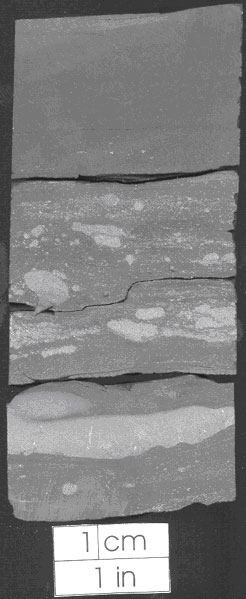 |
|
Kansas Geological Survey Open-file Report 2003-82 |
2.1.10 Phosphatic Black Shale Facies
Description
Very thin laminations (less than 3 mm), fissility, black color, and phosphatic
nodules, characterize this facies (Figure 2.12). Phosphatic nodules are abundant
and also vary in size (0.1 to 1 inch; 0.2 to 2.54 cm). Sparse pyrite and calcite
concretions are also present. Planktonic organisms (such as conodonts) and
disarticulated brachiopods are the only fauna observed in the black shale
facies. No trace fossils or bioturbation were observed. The phosphatic black
shale facies ranges in thickness from 1 to 10 feet with and average of 5 feet
(0.3 to 3 m; average of 1.5 m). Upper and lower contacts are usually sharp,
but the upper contact can be gradational.
Paleoenvironmental Interpretation
The black shale facies was deposited by sediment fallout in either low energy
shallow marginal marine or deep marine environments. The dark black color,
fissility, absence of bioturbation and presence of phosphatic nodules are
indicative of anoxic conditions. Heckel (1977) proposed that upwelling or
pseudo-estuarine circulation would support anoxic conditions in relatively
shallow water. The widespread occurrence of the black shale facies across
the Cherokee basin and into adjacent states suggests a relatively deep marine
environment. The presence of normal marine planktic fauna (i.e. conodonts)
supports an anoxic deep-water environment. This facies is interpreted as deposited
in a shelf environment under anoxic conditions and far removed from sources
of sediment supply. Historically, the phosphatic black shale facies would
be interpreted as part of the "core shale" in the cyclothem model
(Heckel, 1977).
 |
| Figure 2.12 - Polished core section showing the phosphatic black shale facies. Note the abundance of authigenic phosphate nodules (light gray) that widely vary in size. Sample from 414' in the Cooper CW#1 well, 11-T35S-R18E, Labette County, Kansas |
e-mail : webadmin@kgs.ku.edu
Last updated January 2004
http://www.kgs.ku.edu/PRS/publication/2003/ofr2003-82/chapter2_10.html